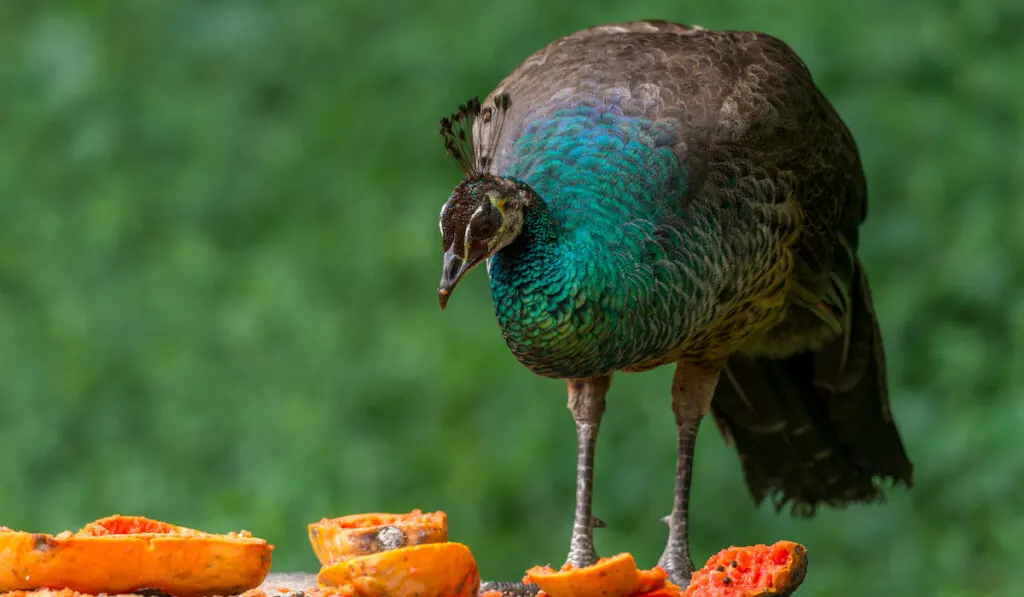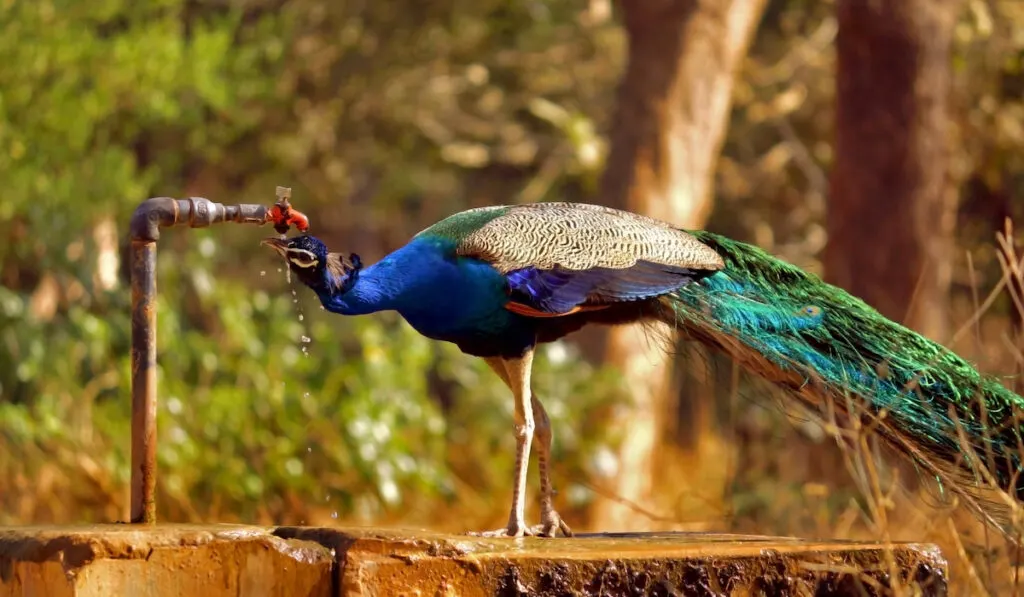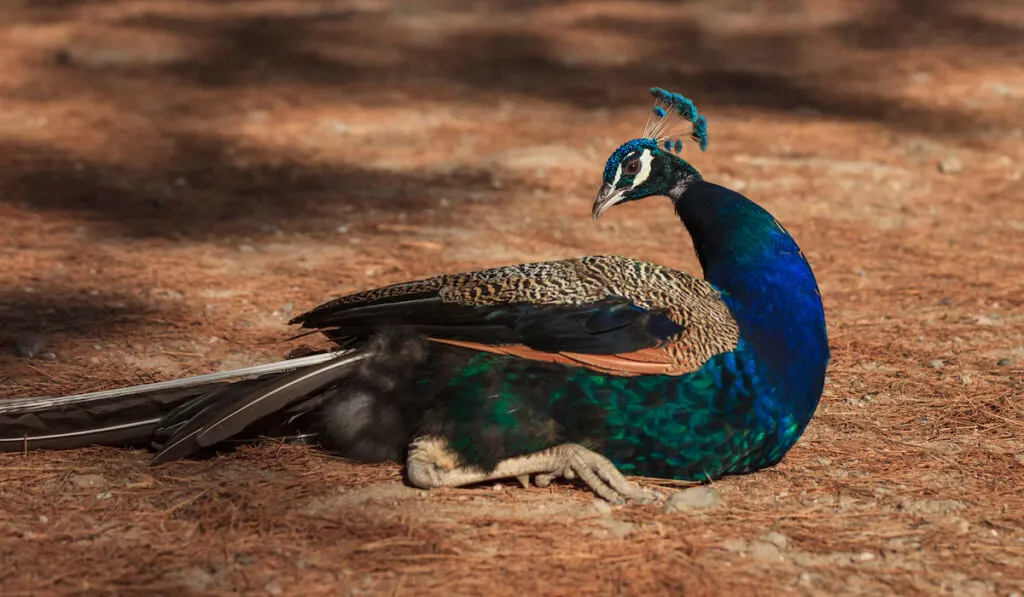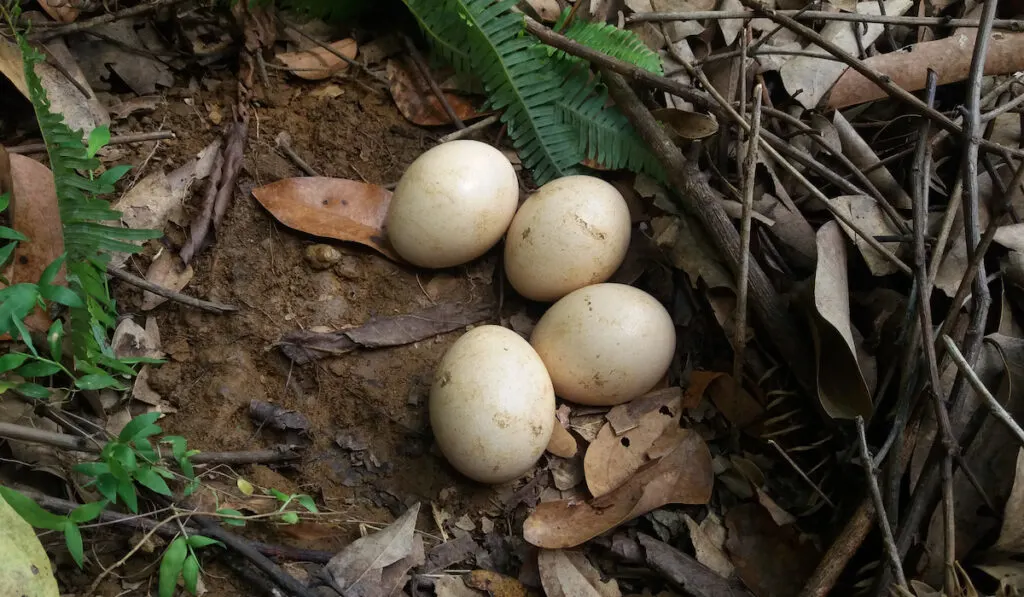Peacocks are exotic, flashy birds that inspire the imagination. The unfurled trains or tails of the males make for a spectacular display in any garden or farmyard.
It is tempting to breed these lovely birds and raise them for personal pleasure or to sell. Any time that you raise animals, it is vital to know their needs and requirements.
Peacocks need a balanced diet of animal protein and plants as they are omnivorous. They must have shelter, roosting perches, nesting boxes, and protection from predators. Water and adequate space are critical. They are prone to internal worms and must be on a deworming schedule.

Peacocks are the glamorous models of the bird world. To be healthy, reproducing, and functioning birds, they must have their specific needs met.
Table of Contents
What Do Peacocks Eat?
Peacocks are omnivores, indicating that they eat animal protein and plants. They can be instrumental in eliminating pests such as slugs, snails, beetles, and locusts. They will also eat small frogs, baby mice if they find a nest, lizards, and worms. You can feed peacocks cat or dog feed to ensure their protein needs are met.
Peacocks have a particular hatred of snakes and will actively attack and eat any snake they find. Both the peacock and the peahen will protect their territory in this way.
In addition to the insects they devour, they will also eat leaves, fruits, vegetables, peanuts, and anything else that catches their interest. Food designed for chickens or pheasants should be offered daily to peacocks in captivity.
Peacocks in the wild have a varied diet to meet their vitamin and mineral needs. It is best to mimic this as much as possible in captivity to ensure they are healthy, lay eggs with strong shells, and produce robust offspring.
What Do Peachicks Eat?
Peachicks can go without food for up to 48 hours after they hatch as they have absorbed the yolk from the egg. They eat a similar diet to their parents, just in smaller pieces. Peachicks are fragile, and it is crucial to ensure they have a good diet.
Medicated high protein game bird crumble can be used for newly hatched chicks. Kitten or puppy food, hard-boiled eggs, seeds, cheese, peelings, or finely cut vegetables can be included.

How to Best Supply Peacocks With Water
Water is essential for all animals, and peacocks are no exception. The easiest water supply to manage is an automatic one connected to the main water supply.
The water system must be checked regularly to ensure the water is clean and there has been no growth of undesirable fungi or mold in the pipes. It is critical to ensure that the system is working every day as it is disastrous if the peacocks are left without water.
A large bucket system that leaks water slowly into a shallow dish is also a good option for a water supply for peacocks. This is usually filled daily and ensures that the peacocks have water for the entire day. These types of water buckets are available at local agricultural stores in various sizes.
If you do not have a bucket system, any bowl or dish can be used to supply water to peacocks. Ensure that it always has water, and remember that it may need to be refilled often during the summer heat.
Peachicks need a shallow pan of water to drink from. They are vulnerable to drowning in deeper containers or bowls of water.
Many people keep peacocks with other birds, such as ducks and geese. If there is a pond, it is important to provide an alternative source of drinking water. Peacocks cannot swim and may fall into the pond when leaning in to drink and drown as a result.

How Much Space Do Peacocks Need?
Peacocks are large birds and need a considerable amount of space. The males’ trains are about five feet long and can be up to five feet tall when displayed. Any nesting area must provide space for all these beautiful feathers.
Peacocks need approximately one hundred square feet of floor space per bird with fencing that is a minimum of six to seven feet high.
Bearing in mind that peacocks are happiest in families of five to six adults, you need to make a large enclosure.
Peacocks, like other birds, want a secure nesting site. Choose a quiet area that has relatively little traffic of any kind. Choose nesting boxes that are sixteen to twenty inches high and big enough to accommodate several peahens at once.
Peahens like company when they are nesting, and it is common for two or three peahens to use the same nesting site. If you have four peahens in an enclosure, you only need two nesting boxes.
There should be a shelter for the peacocks during bad weather. This can be a simple structure, a prefabricated shed, or an elaborate coop. There should be roosting perches, which can be made using 2-by-4 boards. Heated roosting perches can be used in freezing weather when peacocks are prone to frostbite on their toes.
Roosting is natural for peacocks and is how they escape and protect themselves from predators in the wild. Roosting perches allow birds to feel secure when sleeping at night.
The nesting boxes should be situated in the shelter for added protection from the elements and predators. Supply bedding for the nest boxes such as dry grass or straw as it helps with insulation and makes the nest softer.

Should Peacocks Be Enclosed?
Many people love to have peacocks wandering around their garden. It must be remembered that peacocks can fly and are quite apt to explore the neighborhood. This can put them at risk from cars, dogs, coyotes, and other predators. Neighbors may not be happy if your peacocks arrive in their garden.
Although peacocks are large birds, they are still vulnerable to predation. Chicks are small enough to be eaten by other predatory birds, cats, and other wildlife. It is disheartening to watch your prize clutch of chicks be whittled away by the neighborhood hawk or falcon.
If you want to raise peacocks, it is probably best to enclose them in a wire mesh enclosure that includes a roof. The holes in the wire mesh should be small enough to prevent chicks from squeezing through.
It is essential to know the predators in your area and design your peacock enclosure accordingly. Some dogs, coyotes, or other predators may dig under the wire, necessitating some means to prevent this.
Hygiene Is Critical in the Peacock Shed
Maintaining good hygiene standards in the peacocks’ shelter and enclosure is crucial. Birds that roost leave piles of droppings below the roosting perch. These should be regularly cleaned up together with any feces in the rest of the space.
Feces release ammonia, which can cause respiratory disease, foot problems, and make the birds vulnerable to parasites. Bedding in nesting boxes needs to be replaced, and any unfertilized, unhatched eggs must be disposed of.
Allowing the peacocks’ enclosure to become dirty encourages the presence of flies and other nuisance insects. The frequency of cleaning depends on the number of birds but generally should be done once or twice a week.

How Do I Get Peacocks to Stay in My Garden?
It is lovely to have peacocks wandering around a beautiful garden. They are also helpful as they eat insects that may attack plants. The big problem, though, is how to get the peacocks to stay in the garden.
When peacocks are first purchased, they should be enclosed in a wire enclosure for six to eight weeks. They must see the area or garden where they will live. It is critical as it allows them to get used to the site and establish their territory.
After the initial period, the peahens should slowly be let out one by one. The peacock should be the last one released from the enclosure.
It is helpful to establish a routine to feed them in the coop at night and shut them in.
Once the peacocks have established their territory, they will be less likely to fly out of the garden. It is vital that their dietary needs are met or they will feel the urge to look elsewhere for more food.
Lone male peacocks may be tempted to leave the garden to look for a mate. Anytime the birds are startled, peacocks may take flight and accidentally fly out of the garden. You can mitigate this by providing roosts or high trees to which the peacocks can fly if they feel threatened.
Peachicks are always safest when they are enclosed. A valuable way of getting them used to their territory is to put the mother and chicks in a chicken tractor that is moved daily. They should remain in the tractor until the chicks are five months old.
Do Peacocks Get Cold?
Peacocks originated in Asia, India, and Africa. They thrive in deserts, dry grasslands, dense forests, and bushy areas. The common aspect of all the places where peacocks occur naturally is that they are all warm. Peacocks find the cold challenging and need protection from icy weather.
If your area has freezing winters, providing the peacocks with a warm, snug shelter is imperative. It should be large enough for the peacocks to spend most of their day indoors if necessary.
Do Peacocks Get Worms?
Peacocks are known for becoming infested with worms. They should be dewormed every three months as adults. Peachicks can be dewormed starting at one week.
Some people use chicken deworming products, but these only work on select worms and not the entire range of worms. Cattle or sheep deworming products containing one percent ivermectin are effective but should be used under veterinary supervision.

Do Peacocks Lose Their Tail Feathers?
Peacocks reach maturity at three years, which is when they become capable of mating. From that time forwards, the male peacock will lose his train or tail feathers every year after the mating season. Some males lose their feathers rapidly within a week, and others may take several weeks to lose all their feathers.
It is also customary for the male and female peacocks to molt, losing 25% to 75% of their plumage. This allows new feathers to grow in time for winter when healthy, undamaged feathers are essential.
Peacocks are particularly vulnerable during molting as they cannot fly due to the loss of their primaries (long wing feathers). They need care and extra protection from predators. Replacing feathers requires a lot of nutrients, making a good diet critical before and during molting.
Stress and ill health can also cause a peacock to lose its feathers. If you notice your peacock losing its feathers during other times of the year, it would be best to have a health check. Peacocks that are molting or have lost feathers due to ill health must be given a warm shelter to protect them from cold winds or early cold snaps.

How Many Eggs Do Peahens Lay?
Peacocks are not prolific layers and generally only lay a clutch of eggs during mating season. They typically only lay four to eight eggs, some of which may not be fertile. Peachicks that hatch are very precious and must be carefully guarded against predators.
Peahen eggs are three times as large as chicken eggs and are pale brown. The peahen incubates them for 28 to 29 days.
Baby peacocks are tan or brown, which aids them in avoiding predators as they hide in the grass. They begin to get their juvenile plumage at around six months, which resembles the peahen’s colors. They will only grow tail feathers at about eighteen months, but a full male display train is only produced at three years.
How Long Do Peacocks Live?
Peacocks live a long time. The general age span is approximately 15 to 25 years in the wild. Some captive peacocks have lived up until 40 to 50 years.
Conclusion
Peacocks are beautiful birds to breed and raise. They can be an incredible asset in the garden and can be sold for a profit if so desired. They have a broad diet and need protection from the cold and predators.
Resources
- https://animals.mom.com/build-nesting-area-peacocks-8053.html
- https://www.peacocksuk.com/peacock-information/worming-peafowl/
- https://www.farmanimalreport.com/2021/12/05/do-peacocks-shed-their-feathers-molting-4-stages/
- https://www.incubators.org/peacock-egg-incubation.html
